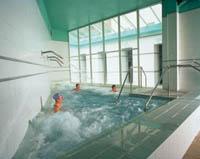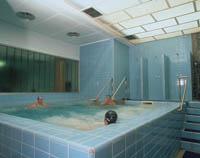Spas: source of health
1999/10/01 Agirre, Jabier - Medikua eta OEEko kidea Iturria: Elhuyar aldizkaria

Relaxing, regaining lost balance and getting it fit is good at any time of year. These objectives can be perfectly fulfilled in the spas distributed throughout our territory. What are spas? They are places for health, rest and beauty, where there is a spring of mineral-medicinal waters with which different treatments can be performed.
For many years, the spas and hot springs that were received in the spas were only a matter of millionaires, and normal people did not have the opportunity to enjoy the local favors. In recent times, however, spas have also adapted to not so equipped pockets, and today we can say that the most sophisticated technique and the most complex (and more expensive) treatment are within reach of everyone.
In which cases are they suitable?
Spa cures are very effective in treating certain diseases. That is why in some European countries, such as Germany, France, Italy or Portugal, public health services cover everything or in part. In Spain, and unfortunately in Euskal Herria, we are not at that level, for older people, for people affected by chronic diseases, and whenever their doctor prescribes this type of therapies, even though the Inserso allows them to go to these places in special economic conditions.
There are many indications that the thermal waters have. In addition to the relaxation and rest that can be achieved in it, mineral-medicinal waters affect muscle relaxation, so they will benefit from osteoarthritis, for example, in the case of muscle aches or tensions that may cause. At the same time, in addition to relieving muscle contraction, hot water has a great anti-inflammatory effect, so the patient has the possibility of performing a series of exercises in hot water that would be impossible outside the water.
On the other hand, depending on the type of water the spa has, depending on the physical and chemical characteristics of the water, other diseases or disorders can be cured. There are waters that come out at high temperature while others come out cold. There are bicarbonated, sulfur, sodium and calcareous waters, radioactive, chlorinated, litinic, with oligo-minerals, silicatadas, bromuradas, etc.
Therefore, and to begin to realize it, they can be improved by balneotherapy, that is, by treating the waters of the spas:
- Diseases of the digestive system. Any digestive dysfunction, including lack of appetite and heartburn or heartburn.
- Respiratory disorders. Asthma and other respiratory conditions. Sulphurous waters are the best in these cases because they decongest the mucosa, so they are recommended for the treatment of asthma and bronchitis.
- Kidney and urinary tract.
- Rheumatological and traumatological diseases. For example, arthritis or osteoarthritis, bone or muscle problems.
- Traffic problems. Poor circulation, varicose veins, etc.
- Gynecological diseases. Clay tampons or vaginal showers act against mucous inflammations, especially in domestic conditions.
- Alterations in nervous systems. Stress, anxiety, but also more complex syndromes such as Parkinson's disease. In hot water, the exercises that the patient must perform in the pools of the march are very appropriate to recover the course and the balance or stability that the patient loses as the disease progresses (Parkinson).
- Skin conditions. Psoriasis or acne, for example.
Hill in the water
Water conditions are mainly of three types.

Mechanics
The body weighs less in the water, so outside the water you can do rehabilitation exercises that would be almost impossible (or totally painful).
Thermal
With hot water (from 37ºC) metabolism is stimulated and a sedative, vasodilator and hypotensive effect is achieved. Cold water, on the other hand, produces a forest constriction (also stimulating), accelerates the function of the thyroid gland and contracts the muscles.
Chemicals
The different minerals and trace elements that present the mineral-medicinal waters are produced through the pores of the skin, spreading throughout the body.
As we have seen, water is the main component of the spa, but clays, algae, massages, physiotherapy or solarium are also used as a complementary method. Water use can be varied (pressure showers, taps, circular showers, swimming pools, steam baths, inhalations or bathtubs) depending on the disease to be treated and the degree of injury of the patient.
Anyone wishing to enjoy the services offered by spas must undergo a prior medical examination detailing their general situation, the severity and severity of their disease. This medical control is necessary for the existence of inadequate treatments in certain diseases. This is the case of heart problems, as large temperature changes can result in excessive expenditure on the heart or even when osteoarthritis is in an acute phase. In these cases the patient should settle for rest and tranquility of resorts.

Gai honi buruzko eduki gehiago
Elhuyarrek garatutako teknologia






